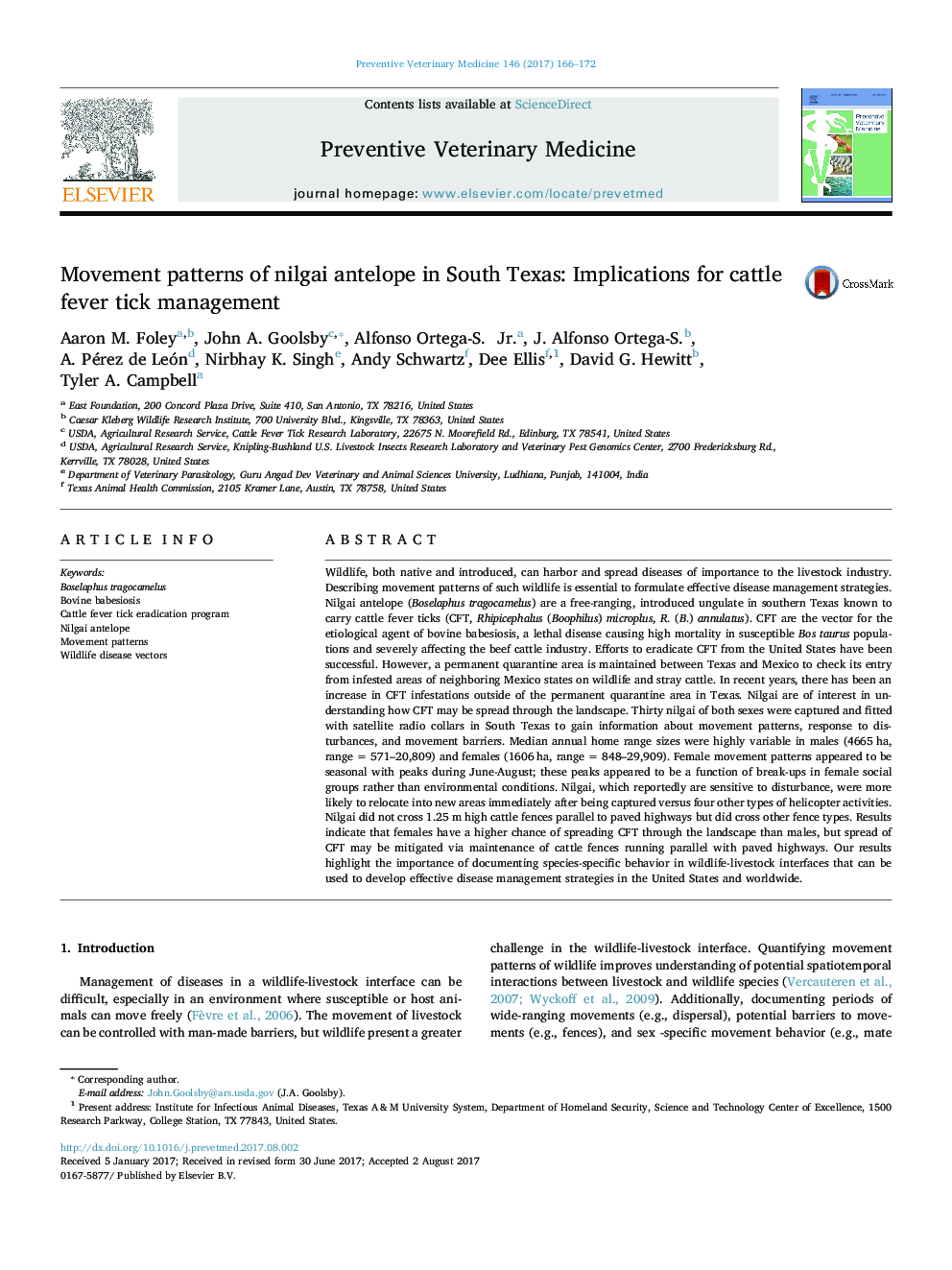| کد مقاله | کد نشریه | سال انتشار | مقاله انگلیسی | نسخه تمام متن |
|---|---|---|---|---|
| 5543501 | 1554144 | 2017 | 7 صفحه PDF | دانلود رایگان |
عنوان انگلیسی مقاله ISI
Movement patterns of nilgai antelope in South Texas: Implications for cattle fever tick management
ترجمه فارسی عنوان
الگوهای حرکت جنس نیلگای در جنوب تگزاس: پیامدهای برای کنترل گاو تب
دانلود مقاله + سفارش ترجمه
دانلود مقاله ISI انگلیسی
رایگان برای ایرانیان
موضوعات مرتبط
علوم زیستی و بیوفناوری
علوم کشاورزی و بیولوژیک
علوم دامی و جانورشناسی
چکیده انگلیسی
Wildlife, both native and introduced, can harbor and spread diseases of importance to the livestock industry. Describing movement patterns of such wildlife is essential to formulate effective disease management strategies. Nilgai antelope (Boselaphus tragocamelus) are a free-ranging, introduced ungulate in southern Texas known to carry cattle fever ticks (CFT, Rhipicephalus (Boophilus) microplus, R. (B.) annulatus). CFT are the vector for the etiological agent of bovine babesiosis, a lethal disease causing high mortality in susceptible Bos taurus populations and severely affecting the beef cattle industry. Efforts to eradicate CFT from the United States have been successful. However, a permanent quarantine area is maintained between Texas and Mexico to check its entry from infested areas of neighboring Mexico states on wildlife and stray cattle. In recent years, there has been an increase in CFT infestations outside of the permanent quarantine area in Texas. Nilgai are of interest in understanding how CFT may be spread through the landscape. Thirty nilgai of both sexes were captured and fitted with satellite radio collars in South Texas to gain information about movement patterns, response to disturbances, and movement barriers. Median annual home range sizes were highly variable in males (4665 ha, range = 571-20,809) and females (1606 ha, range = 848-29,909). Female movement patterns appeared to be seasonal with peaks during June-August; these peaks appeared to be a function of break-ups in female social groups rather than environmental conditions. Nilgai, which reportedly are sensitive to disturbance, were more likely to relocate into new areas immediately after being captured versus four other types of helicopter activities. Nilgai did not cross 1.25 m high cattle fences parallel to paved highways but did cross other fence types. Results indicate that females have a higher chance of spreading CFT through the landscape than males, but spread of CFT may be mitigated via maintenance of cattle fences running parallel with paved highways. Our results highlight the importance of documenting species-specific behavior in wildlife-livestock interfaces that can be used to develop effective disease management strategies in the United States and worldwide.
ناشر
Database: Elsevier - ScienceDirect (ساینس دایرکت)
Journal: Preventive Veterinary Medicine - Volume 146, 1 October 2017, Pages 166-172
Journal: Preventive Veterinary Medicine - Volume 146, 1 October 2017, Pages 166-172
نویسندگان
Aaron M. Foley, John A. Goolsby, Alfonso Jr., J. Alfonso Ortega-S., A. Pérez de León, Nirbhay K. Singh, Andy Schwartz, Dee Ellis, David G. Hewitt, Tyler A. Campbell,
